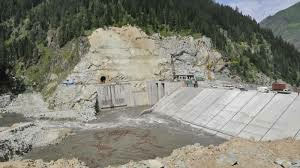Srinagar
The expert panels of India’s environment ministry have recommended environment and forest clearance to the Ujh multipurpose hydropower project in Indian illegally occupied Jammu and Kashmir.
The project envisages construction of a 116-metre dam and needs diversion of 4,350 hectares of land, which includes about 680 hectares of forest land and clearance of 214,502 trees.
The project was declared by Indian government as a national project in 2008, is part of India’s endeavour to step up use of the water available under the Indus Water Treaty.
India’s environment ministry’s expert panels in their meetings in December 2020 have recommended clearance for the Ujh multipurpose hydroelectric project in Kathua area of IIOJK for which 214,502 trees in the ecologically sensitive area will need to be cut.
The project is envisaged on River Ujh, which is a tributary of River Ravi that flows into Pakistan and is part of the Indus river basin system. Over the past few years, as the political relationship with Pakistan deteriorated, India’s endeavour has been to accelerate the utilisation of the water it has rights over, under the Indus Water Treaty. Indus Water Treaty is an agreement signed between India and Pakistan that details the sharing of waters from the Beas, Ravi, Sutlej, Indus, Chenab and Jhelum rivers.
Ujh Project is a multipurpose project (hydropower, irrigation and drinking) and the total land required for the project is about 4,350 hectares (ha) – over twice the size of Delhi airport. Of the total land required, the submergence area is 3,450 hectares which comprise 329 hectares of government land, 680.1 hectares of forest land and 2,441 hectares of private land.
The project, involves the construction of 116-metre high concrete face rock fill dam, a powerhouse of installed capacity 186 megawatts and a barrage 11.5 kilometre downstream of the dam. The irrigation benefits from the project will comprise annual irrigation of about 31,380 hectares.
Meanwhile, Jammu and Kashmir social activist, Raja Muzaffar Butt remarked, in IIOJK, every year hundreds of thousands of trees are cut for one project or another such as highways, roads, dams.”
“No one is against development but what we want is green development – a development that takes into account concerns related to forest, tribal people, and environment. It needs to be sustainable. A rough estimate states that over two million trees have been cut over the last 15-20 years in the territory. This impacted the microclimate of the area as well. While taking up the developmental projects, the government of India must ensure that they don’t violate the commitments India made vis a vis environment and climate change under the sustainable development goals,” Butt told Mongabay-India.—KMS








